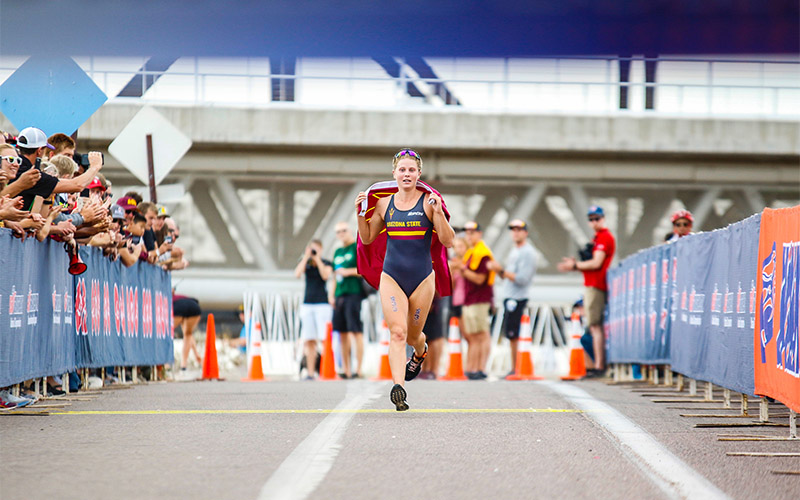TEMPE – In 2016, 47 athletes attended the women’s collegiate triathlon national championships. The following year, held in Tempe Town Lake, the event nearly doubled its participants.
This quick growth of women’s collegiate triathlon helped the sport reach its quota, 40 schools, and now it is in prime position to become the latest NCAA championship sport, officially cementing its position in collegiate athletics.
Although the quota has been met, NCAA women’s triathlon isn’t stopping there.
“It’s an incredibly exciting time for the sport and now that we’ve hit 40 schools, we have momentum on our side,” Rocky Harris, CEO of USA Triathlon and a former Arizona State assistant athletic director, wrote in an email. “We’re talking to schools every day, including several Division I schools, and we’re expecting to see more Power Five conference schools come onboard.”
Of the 41 schools that have a women’s triathlon program, only 10 are Division I. These schools span across the country, ranging from TCU to Delaware State to San Francisco to Wagner. Sitting atop the food chain and winners of the last five national championships is a maroon and gold team from Tempe: Arizona State.
“I’m not going to say we’re an Alabama yet,” ASU triathlon coach Cliff English said. “But when people are like ‘man, I want to go to that school because of their program,’ it’s definitely a really nice bonus, and it also makes you feel like you’re doing the right thing and doing a good job.”
English has developed Arizona State into a national power. On March 14, he was named the 2021 USA Triathlon College Coach of the Year.
?️ We hit 40 programs! ?
This is a historic moment, as women's collegiate triathlon is on the doorstep to becoming the newest @NCAA championship sport! ?
We're proud to be part of the triathlon family! ?
? – https://t.co/2PUi6EHIVr #ForksUp /// #NCAATri pic.twitter.com/Ut8YtNyBrR
— Sun Devil Triathlon (@sundeviltri) February 17, 2022
While doing so, he was simultaneously developing triathlon into one of the fastest growing sports in the country.
English was appointed as the Division I representative for the College Triathlon Coaches Association (CTCA) back on April 19, 2017.
Currently listed as an NCAA Emerging Sport for Women, English expects triathlon to become an official championship sport within the next 18 months.
The NCAA identifies an emerging sport as one “recognized by the NCAA that is intended to explore new sports and grow participation opportunities for female student-athletes.” Universities are permitted to use emerging sports to help meet the NCAA minimum sports sponsorship requirements as well as gender equity standards.
Other NCAA sports, such as gymnastics or hockey, may demand certain infrastructure to be built in order to accommodate it.
In English’s eyes, this is a positive when pitching the sport.
“If you’re an (athletic director), and you’re thinking about your budget, you have a swim team, you have a pool, you’re good to go,” English said. “You have a track team, a cross-country team, you have running areas that you can go to nearby or approximate to your school, and a track. You’re good to go.”
The closest school to ASU in Division I is San Francisco, still requiring a not-so convenient 12 hour trip if the travel is done by car.
In the past, Arizona State talked with the University of Arizona and Northern Arizona University, but ultimately resulted in no concrete progress for the two schools adding the sport. English hopes these conversations will continue to happen in the future.
“Certainly for us, it’d be a priority to have schools proximate to us as well, and it gives us a little more ability to have dual meets and start a conference,” he said.
For ASU, triathlon became a sport for the 2016 season. Former ASU graduate student and current triathlon assistant coach Nicole Welling had an integral role with the sport in its infancy. In 2015, Welling pitched the sport to Ray Anderson, Arizona State’s Vice President for University Athletics.
“So I had one conversation with Ray. … it was just kind of like, right place right time,” Welling said.
“Fortunately, the year we added the sport in 2016, the U.S. won their first gold medal in women’s triathlon,” she added. “That was kind of part of my pitch was like, ‘Hey, this is a really up-and-coming sport, we’ll be the first major Division I (school) to add the sport. This is just a really cool moment to become a part of the sport.’”
Once any school branches out and adds triathlon, the next step is recruiting athletes. Unlike other more commonly known sports, high schools typically don’t have triathlon teams.
Athletes such as junior triathlete Liberty Ricca are often recruited primarily for one out of the three sports in triathlon: running, biking or swimming.
“I was recruited a lot for running in college,” Ricca said.
Five straight national championships for @sundeviltri, and now the 2021 Zone3 College Coach of the Year! ?
Congratulations, ????? ???????! ?
? – https://t.co/l2aU2pg5qi pic.twitter.com/8dHMjqYdjb
— USA Triathlon (@usatriathlon) March 14, 2022
Outside of high school, however, triathletes will find other avenues to pursue the sport.
“A lot of these young women are already, whether they’re on the track team, cross country and swimming, they’re already going out and seeking out triathlon clubs,” English said. “They’re going and finding a coach and finding a team. They’re training on these teams. They’re going around the country competing in triathlons. It’s a very big circuit.”
Although English prefers to focus on college sports rather than professional, his eyes are set on the Olympics, especially in 2028 when the Summer Games come to Los Angeles.
“If this also provides a launching pad for a future Olympian … that’s why I’m here too,” English said.
“Reaching NCAA championship status will be big for the Olympic pipeline,” Harris said. “You look at other Olympic sports – like swimming – most Olympians competed in their sport at the college level. By bringing triathlon to Division I athletics it gives us four years to train these future Olympians.”
Because of Title IX, it is unlikely that men’s triathlon will follow suit and become an NCAA Emerging Sport.
However, triathlon, as a sport with the option of including mixed-gendered competition, feels inclusive to Sun Devil triathlete Alexe Coursol.
“It’s a growing sport that connects everyone,” Coursol said. “Girls have the same opportunities as guys in triathlon, whether it comes from prize money, or whether it comes from sponsors. I think that is something really valuable that I enjoy about my sport.”
ASU triathletes are witnessing history within their sport. Regardless of whether triathlon is recognized as an NCAA championship sport, the mindset of the five-time defending national champion Sun Devils doesn’t change.
“We are living in the moment,” Ricca said. “Yeah, it’s a NCAA sport, but that means we have more competition coming in soon, so we need to make sure that we are still in shape and ready to defend our title.”
Arizona State has had undeniable success in the sport. While the Sun Devils enjoy building their triathlon dynasty, the sport is also helping fuel something on a more general scale: women’s athletics.
On the 50th anniversary of Title IX, women’s triathlon acts as another big step in half a century of progress.
“Women’s triathlon becoming an NCAA championship sport sends a resounding message across the country that women’s sports are thriving,” Harris said. “This is an important step in continuing to grow the sport of triathlon and growing the sport’s popularity among the important young demographic.”
The impact is visible at the women’s collegiate level. However, the effect of this sport becoming official trickles down far below colleges.
Eventually, it trickles all the way down to youth sports.
“Now, young athletes, 8, 9, 10 years old just starting the sport have the opportunity to someday race at the NCAA level, to be an NCAA champion, be a part of a collegiate team, to race on TV,” Harris said.


